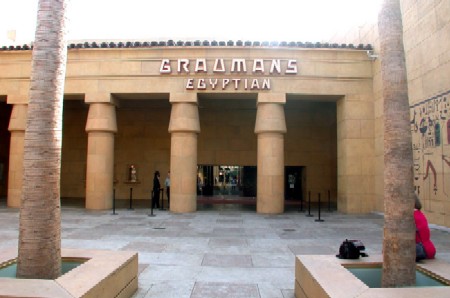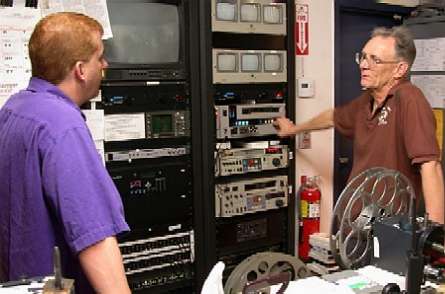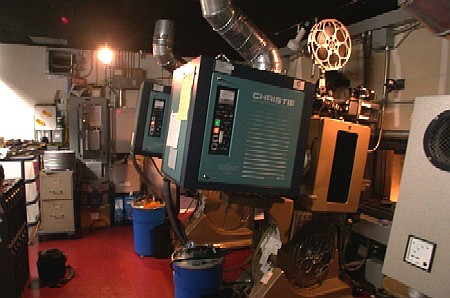4-track Magnetic stereo at The American Cinematheque, Hollywood |
Read more
at in70mm.com The 70mm Newsletter |
| Pictures and story by: Richard Greenhalgh | Date: December 2002 |
 On
December 8, 2002, the American Cinematheque screened a very interesting
and unique piece of motion picture history, as a part of their excellent
4-Track Mag Stereo Film Festival, as they described in their announcement: On
December 8, 2002, the American Cinematheque screened a very interesting
and unique piece of motion picture history, as a part of their excellent
4-Track Mag Stereo Film Festival, as they described in their announcement:
"4-Track Magnetic Stereo and Cinemascope Demonstration Film" 1953, 20th Century Fox, approx. 90 min. This incredibly rare, 5-reel film was produced in 1953 by 20th Century Fox to sell theatre owners on the then-brand new technologies of 4-track mag stereo and Cinemascope projection. Hosted by legendary Fox studio head Darryl F. Zanuck, the film features clips from several of the first Cinemascope and stereo productions being made at the studio in the early 1950's. Please note that this, the only surviving print, is extremely faded; because of its rarity, we're including it here as a free event. |
More in 70mm reading: Gallery: Hollywood's Egyptian Theatre Exteriors, 2004/05 Paul Rayton In Conversation Technicolor Festival #4. 8. - 10. Juli 2022 Remembering Richard Greenhalgh May 29, 1948 – September 5, 2011 The American Cinematheque's Second 70mm Festival PDF: Boston Light and Sound, 1998 Egyptian brochure |
 Projectionist
Paul Rayton giving the audience an intro to the CinemaScope demo film. Projectionist
Paul Rayton giving the audience an intro to the CinemaScope demo film.
This untitled presentation was screened at 2.55:1 in 4-track mag
stereo, which was a rare treat. It was introduced by
Paul Rayton, of the
American Cinematheque, who explained that it was the only surviving print.
He said that it was cut from various pieces of film and that the sound
track had then been recorded on the film. Therefore, there is no negative.
It is marked Print #10 and so he assumed that there had been at least 9
other prints. The first 12 minutes of the presentation was a Technicolor IB print re-cut from "The Miracle of Stereophonic Sound in
Association with CinemaScope" (see below). This featured the use
of "CinemaScope Stereo" in scenes of a train travelling across
the screen, jets flying from left to right and a band marching down
Colorado Boulevard during the Rose Parade in Pasadena, California,
partially in front of the Academy Theater, which was then showing a
CinemaScope feature on their marquee. |
|
 Projectionist
Paul Rayton (right) talking with guest Projectionist
Paul Rayton (right) talking with guestDarryl F. Zanuck introduced the balance of the presentation which included clips from upcoming CinemaScope releases. He extolled the virtues of Fox's new wide screen process by showing the same scene framed at 1.37:1, then in the "new" wide screen format at 1.85:1 and finally in CinemaScope at 2.55:1. Extensive clips were shown from "Broken Lance," "A Woman's World," "Untamed," "No Business Like Show Business," "Garden of Evil," "Pink Tights" (with Sherrie North) and, according to Mr. Zanuck, the first film entirely shot with the "new" lenses, "The Egyptian." Mr. Zanuck showed a number of books each of which represented new CinemaScope releases in, or soon to be in, production from Fox and other studios. The presentation ended abruptly which lead to the conclusion that it was ended with an in-person wrap-up for the theater owners. |
|
 The
DP70s of the Egyptian Theatre The
DP70s of the Egyptian TheatreFor those of us who also stayed for the screening of "Pepe", we were treated to a showing of "The Miracle of Stereophonic Sound in Association with CinemaScope." Rick Mitchell, noted film historian, was kind enough to provide the following information about this short:
|
|
|
Go: back
- top - back
issues - news index Updated 22-01-25 |
|
